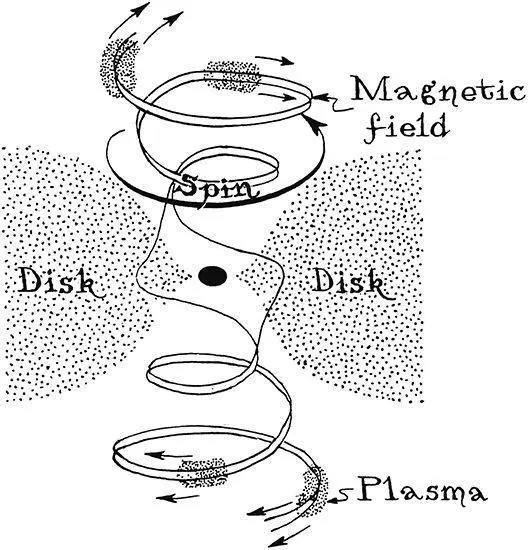Black Holes and Accretion Disks
How could so much power come out of a region so small? When we think about the fundamental forces in Nature, there are three possibilities: chemical energy, nuclear energy, or gravitational energy.
Chemical energy is the energy released when molecules combine together to make new kinds of molecules. An example is burning gasoline, which combines oxygen from the air with gasoline molecules to make water and carbon dioxide, and a lot of heat. The power from that would be far, far, far too little though.
Nuclear energy results when atomic nuclei combine together to make new atomic nuclei. Examples are an atomic bomb, a hydrogen bomb, and the burning of nuclear fuel inside a star. Though this can be far more powerful than chemical energy (think of the difference between a gasoline fire and a nuclear bomb), astrophysicists couldn’t see any plausible way for nuclear energy to power quasars. It was still too puny.
So the only possibility left was gravitational energy , the same kind of energy we were driven to, when navigating the Endurance around Gargantua. For the Endurance , gravitational energy was harnessed by a slingshot around an intermediate-mass black hole (Chapter 7). The black hole’s intense gravity was key. For quasars, similarly, the power must come from a black hole.
For several years, astrophysicists struggled to figure out how a black hole could do the job. The answer was found in 1969, by Donald Lynden-Bell at the Royal Greenwich Observatory in England. A quasar, Lynden-Bell hypothesized, is a gigantic black hole surrounded by a disk of hot gas (an accretion disk) that is threaded by a magnetic field (Figure 9.2).
Hot gas in our universe is almost always threaded by magnetic fields (Chapter 2). These fields are locked into the gas; the gas and fields move together, in lockstep.
When threading an accretion disk, a magnetic field becomes a catalyst for converting gravitational energy into heat and then light. The field provides ultrastrong friction [21] The friction arises through a complex process where moving gas winds the field up, strengthening it and thereby converting energy of motion into magnetic energy; and then the magnetic field, pointing in opposite directions in neighboring regions of space, reconnects and in the process converts magnetic energy into heat. That’s the nature of friction: a conversion of motion into heat.
that slows the gas’s circumferential motion, reducing the centrifugal force that holds it out against the pull of gravity, so the gas moves inward, toward the black hole. As the gas moves inward, the hole’s gravity speeds up its orbital motion by even more than the friction slowed it. In other words, gravitational energy is converted into kinetic energy (energy of motion). Magnetic friction then converts half that new kinetic energy into heat and light, and the process repeats.
The energy comes from the black hole’s gravity. The agents for extracting it are magnetic friction and the disk’s gas.
The quasar’s bright light, seen by astronomers, comes from the disk’s heated gas, Lynden-Bell concluded. Moreover, the magnetic field accelerates some of the gas’s electrons to high energies; and the electrons then spiral around the magnetic force lines, emitting the quasar’s observed radio waves.
Lynden-Bell worked out the details of all this using a combination of the Newtonian, relativistic, and quantum laws of physics. He easily explained everything about quasars that astronomers had seen, except their jets. His technical article describing his reasoning and his calculations (Lynden-Bell 1979) is one of the great astrophysics articles of all time.
The Jets: Extracting Power from Whirling Space
Over the next few years, astronomers discovered many more jets sticking out of quasars and studied them in great detail. It soon became clear that they are streams of hot, magnetized gas ejected from the quasar itself: from the black hole and its accretion disk (Figure 9.2). And the ejection is extremely powerful: the gas travels out the jets at nearly the speed of light. As it travels, and when it plows into material far from the quasar, the gas emits power in light, in radio waves, in X-rays, and even in gamma rays. The jets are sometimes as bright as the quasar itself, a hundred times brighter than the brightest galaxies.

Fig. 9.2. Artist’s conception of an accretion disk around a black hole, and jets emerging from near the hole’s poles. [Drawing by Matt Zimet based on a sketch by me; from my book Black Holes & Time Warps: Einstein’s Outrageous Legacy .]
Astrophysicists struggled for nearly a decade to explain how the jets are powered and what makes them so fast, so narrow, and so straight. The answers came in several variants, with the most interesting in 1977 from Roger Blandford at the University of Cambridge, England, and his student Roman Znajek, building on foundations laid by the Oxford physicist Roger Penrose; see Figure 9.3.
The accretion disk’s gas gradually spirals into the black hole. When crossing the hole’s event horizon, each bit of gas deposits its bit of magnetic field onto the horizon, and then the surrounding disk holds it there, Blandford and Znajek concluded. As the black hole spins, it drags space into whirling motion (Figures 5.4 and 5.5), and the whirling space makes the magnetic field whirl (Figure 9.3). The whirling magnetic field generates an intense electric field like in a dynamo at a hydroelectric power station. The electric field and the whirling magnetic field together fling plasma (hot, ionized gas) upward and downward at near light speed, creating and powering two jets. The jets’ directions are held steady (when averaged over years) by the black hole’s spin, which is steady due to gyroscopic action.

Fig. 9.3. Blandford-Znajek mechanism for generating jets. [Drawing by Matt Zimet based on a sketch by me; from my book Black Holes & Time Warps: Einstein’s Outrageous Legacy .]
In 3C273 only one jet was bright enough to see (Figure 9.1), but in many other quasars both are seen.
Blandford and Znajek worked out the full details, relying heavily on Einstein’s relativistic laws. They were able to explain most everything about the jets that astronomers see.
In a second variant of the explanation (Figure 9.4), the whirling magnetic field is anchored in the accretion disk instead of the hole, and is dragged around by the disk’s orbital motion. Otherwise, the story is the same: dynamo action; plasma flung out. This variant works well even if the black hole isn’t spinning. But we’re pretty sure that most black holes spin fast, so I suspect the Blandford-Znajek mechanism (Figure 9.3) is the most common one in quasars. However, I may be prejudiced. I spent much time in the 1980s exploring aspects of the Blandford-Znajek ideas and even coauthored a technical book about them.

Fig. 9.4. Like Figure 9.3 but with magnetic field anchored in the accretion disk. [Drawing by Matt Zimet based on a sketch by me; from my book Black Holes & Time Warps: Einstein’s Outrageous Legacy .]
Whence Comes the Disk? Tidal Forces Tear Stars Apart
Читать дальше















